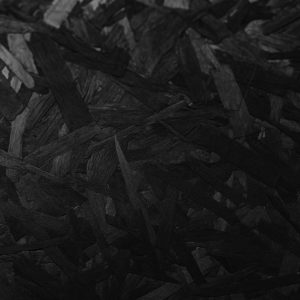FORGED CARBON

Similar to woven carbon fibres, forged carbon is a composite material. Instead of being woven, the fibres are cut into segments of a few millimetres, which are then mixed in randomly into the resin matrix or placed in a specific order.
History
The production of carbon fibres from polymer monofilaments (PAN method) used in watchmaking was patented in 1963. The industrialisation of carbon components began in the 1970s. Due to high production costs, their use was initially limited to the aerospace and aviation industries. As production costs decreased, carbon fibres became more accessible in the 1990s. By the end of this decade, woven carbon fibres were found in all external watch components. Ten years later, the first movement parts (mainplates and bridges) made from this material were introduced. Forged carbon appeared at the beginning of the 21st century and is appreciated for use in both external parts and movement components (mainplates and bridges).
Synthesis of Fibres
The synthesis of carbon fibres used to reinforce composite materials can be obtained from polymer monofilaments (PAN process), hydrocarbons (oil, coal), or celluloses. In watchmaking, the PAN method is generally used. Various chemical and thermal processes (pyrolysis) are used to eliminate atoms other than carbon (carbonisation at around 1500°C), and even to add carbon atoms (graphitisation) to produce filaments with a carbon content greater than 90%.
Composite Structure
The filaments, which have a diameter between 5 and 10 micrometres, are cut into regular segments that can be several millimetres long. The fibre segments can then be mixed with the resin matrix randomly or oriented along a specific axis. The orientation and density of the carbon fibre segments provide significant variability in the composite’s mechanical properties.
Curing
The composite can be placed in a mould to be cured in an autoclave oven at temperatures up to 250°C and maximum pressures of 15 bar, producing blocks that can then be machined. New technologies allow the production of more resistant forged carbon by optimising manufacturing time. One such technology involves replacing the autoclave oven with a press with a heated mould. A mould ventilation system allows working at higher temperatures without damaging the resin. The press can also achieve pressures of up to 250 bar. The forged carbon blocks are then ready for machining.
Machining
The machining of forged carbon blocks can include conventional operations: turning, milling, and drilling. The tools for this process are made from ceramic, cemented carbide, polycrystalline diamond, and cubic boron nitride. Due to its low thermal conductivity, carbon retains heat and transfers very little of it to the tool. However, excessive heat can damage the matrix resin and compromise the material’s properties. Therefore, forged carbon machining requires more time, especially since the material generally does not tolerate coolant. Once the component is created, various finishing operations are possible: trimming, polishing, applying a matte or glossy varnish, etc.
Properties of Forged Carbon
Forged carbon is lightweight and exhibits excellent tensile and compressive strength. It has high resistance to crack propagation (toughness) and excellent resilience to abrasion and corrosion. Additionally, forged carbon has a very low coefficient of thermal expansion. The modulus of elasticity of forged carbon varies according to the fibre density and the nature of the matrix, but it remains consistently high. As a result, forged carbon components are highly resistant to deformation but can break under certain stresses. Forged carbon has a marbled appearance, distinct from the woven patterns of carbon fibre cloth. The quality of forged carbon can vary significantly depending on the carbon density of the composite.
Applications in Watchmaking
Forged carbon is appreciated for the manufacture of all external components (cases, straps, dials). Occasionally, it is used to produce mainplates and bridges.
